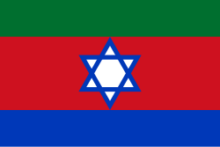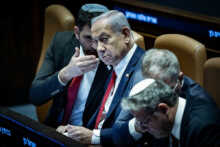Four general elections in two years, it’s a record hard to beat. It looks like Israel is competing with post-war France or with Italy in the 1970s for political instability. Why? Because one man, Benyamin Netanyahu, is holding on to power at all costs. Why? To flee from accusations levelled against him for corruption, fraud, abuse of confidence, conflict of interest, concussion and personal enrichment. The only way to avoid his trial is to hold onto his seat at the head of the government, even if he’ll have to appear before his judges once his ceases to lead the destinies of his country. As far as democracy is concerned, we’ve seen better.
But there’s worse than that. Let’s have a quick look at a number of events during recent election campaigns. Two weeks before the vote in April 2019, Israeli forces pounded Gaza with no less than 100 air raids. And just before the vote of September 2019, Israeli aviation bombed Syria, Iraq and Lebanon. In November 2019 the deadline imposed by Israel’s electoral law was approaching for the formation of a new government. It was then that the Israeli army committed extrajudicial executions by assassinating two leaders of the Islamic Djihad in Damascus and Gaza, not to mention the usual air strikes against this Palestinian enclave, killing more than 30 civilians. And two weeks before the vote in March 2020, bomber jets once again struck Syria and the Gaza Strip. As cynical as it is criminal, it’s classical on the approach of elections in the Hebrew state. Threats of war always favour the war lords, and it is the latter who are indeed in power in Tel Aviv.
In 2019 the first vote in the general election resulted in an advance for Netanyahu’s Likud party, which formed a minority government. The last vote in 2019, held in November, resulted in a stalemate between Netanyahu and his main rival Benny Gantz (Blue-White party), who both obtained the same number of seats and practically the same number of votes (26.5% and 26.11% respectively). They were supposed to practice « alternation » as Prime Minister at midterm, but before General Gantz was able to access this position parliament was dissolved on 23 December for lack of an agreement on the budget, once again triggering off a new election.
With Netanyahu at its head, Likud and its far right allies have been governing the country for more than 10 years on a programme of occupation, colonial expansion and militarism, sometimes pointing their gun barrels at neighbouring countries (Lebanon, Syria and even Iraq) and sometimes at Palestinians in the Occupied Territories. Netanyahu outdid himself in his last two mandates with the proclamation of the « Nation-State of the Jewish People » (denying the rights of 1948 Palestinians, citizens of Israel) and the establishment of official relations with several Arab countries (United Arab Emirates, Bahrain, The Sudan and Morocco). And “Bibi” announced plans to annex 30% of the occupied West Bank, however without being able to implement that annexation. All of this goes in the direction of burying any perspective of a negotiated peace with the Palestinians.
And yet, an unexpected force burst onto the Israeli scene in this devastated political landscape: the Joint List. It’s not just one more electoral coalition of Zionist parties but an alliance between Communist and Arab parties. As of 2015 it became the third largest parliamentary group in the Knesset and it remains so today. And its traditional bastion (1948 Palestinians, which make up 20% of the population) enlarged itself to a new electorate: part of the Jewish vote in Israel. Progressive Jews traditionally voted for the Zionist left (Labour, Meretz) with a residual vote for the Community Party, whose stable electoral base remains amongst the Palestinian population of Israel. But now, over the last few years, an increasing number of Israeli Jews vote for Hadash (the Israeli CP) and the Joint List. This was the case with the general election held in September 2019 when a hundred academics called upon their Jewish compatriots to vote for the Joint List, that they described as « the house of all those who believe in total civic and national equality for Arabs and Jews, who want to put an end to the Occupation, who want democracy, peace and social justice”. Their call was answered and the Jewish vote enabled this list to maintain its position as the third largest parliamentary group. At the last general election, more than 20,000 Jewish voters cast their ballot in favour of this Communist-Arab coalition. In the March 2020 election in certain cities with a left wing majority, the number of Jews who voted for the Joint List doubled.
And Jewish opposition against the Occupation and the situation of Apartheid imposed on Israel’s Arab minorities (1948 Palestinians and Bedouins) doesn’t only express itself in ballot boxes – it especially does so in the streets. For the last six months Israelis have been demonstrating every Saturday against their government to denounce the disastrous management of the sanitary crisis and the economic crisis. But the Palestinian question is never far away in these marches and rallies, in which Jewish and Arab citizens demonstrate together.
And that’s where hope can be found for the future, be it on the occasion of the next election or further on in the years to come. In order to put an end to the colonization of the Occupied Territories and Israeli Apartheid inside the borders of the Hebrew state, a radically different is necessary. On voting day (which takes place often in Israel these days) it could appear as a broad gathering of voters – both Jewish and Arab – on the basis of democratic and anticolonial demands. In the Occupied Territories it’s the resistance of the Palestinians which remains an indispensable element. This resistance never ended, even if it has taken on different forms over the years. All of this is going on with the active support of the international solidarity movement, largely incarnated by the BDS campaign. It is these forces, inside and outside of Israel, which can rid us of Netanyahu, Gantz and their mindless intention of perpetrating a never-ending Occupation.
Despite everything, the March 2020 election could have taken place differently. Because instead of making a pact with his rival Netanyahu – with whom he previously vowed never to make an alliance – Gantz could have made a quite different choice given the political arithmetic at hand, with a kaleidoscope of small parties present in the Knesset. Form a coalition with the Joint List? That would have given him a majority to govern. But to do so he would have to accept the conditions of this list: equality of rights for Palestinian citizens of Israel, abrogation of the « Nation-State » law and withdrawal from the Territories, paving the way for the creation of a viable Palestinian state with Jerusalem-East as its capital. Obviously, what Gantz lacked was the political will to accept these terms, as such a scenario would go against the policies he professed ever since he got involved in politics. He thus preferred to forget his commitment not to align with “Bibi”. The promise of becoming Prime Minister in the short term – even if this didn’t come about – was enough to have him renounce on the “principals” he ostensibly proclaimed just a few weeks earlier.
Before the April 2019 vote, Benny Gantz bragged to have « reduced Gaza to the stone age » and he had already given a taste of his medicine when he was Chief of Staff in 2014 during operation “Protective Seam”: 2,200 Palestinian deaths in Gaza, essentially civilians, with the use of prohibited weapons (white phosphor). He obviously chose the path of war. At the approach of new elections, it is now up to progressive Jews in Israel to choose the path of peace with their Palestinian compatriots, both in the streets and in the ballot boxes.
Richard Wagman
25/12/20




